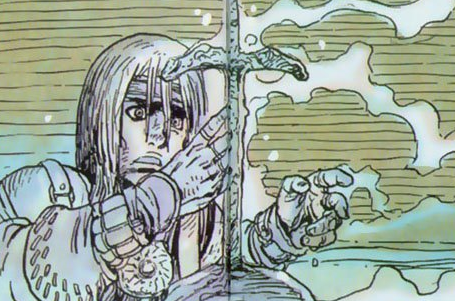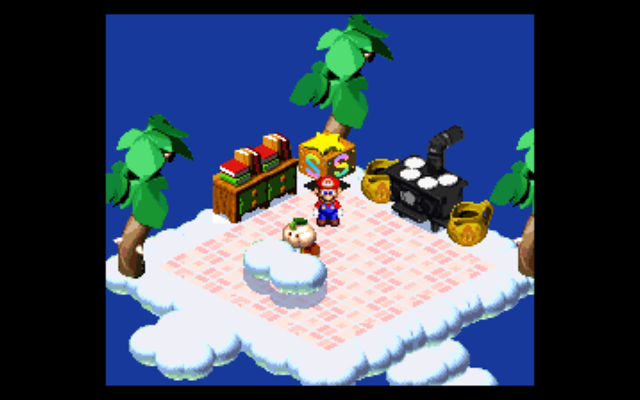Because I've recently espoused my thoughts on collaborative gameplay - from my earlier Donkey Kong Country shpiel - it seems appropriate to rehash the concept. Sitting around playing Nintendo has been a staple of the quality time spent with my brothers. The four-brothers/four-players algorithm has governed these sessions for decades, and still hold true today. I bring this up because recently John and I have been playing a lot of Super Mario World for the SNES and everything time we boot it up, despite how fun it is, I end up asking myself why it took Nintendo so long to allow their consumers to play collaboratively all at once.
Super Mario 3d World has pretty much crowned itself as king in that department - embodying all the madness and bedlam of four players bouncing shells, stars, coins, and each other into abysses in a frantic scramble to reach Bowser's castle while also drawing out their innate ruthlessness by having them each compete for a crown which benefits them nothing but the right to wear a crown. It is not uncommon to see Luigi cut a drawbridge; sending Mario, Peach, and Toad all plummeting to their loudly belligerent deaths for the sake of racking up an easy 4, 000 points. Or for Luigi to be hurled cruelly off a ledge, in turn, to steal back the crown. I feel I will soon dedicate a whole post to this marvelous little jewel of a game, but don't feel like digressing just yet.
This is all even more curious since games have efficiently been doing since River City Ransom or Battletoads. There is something cathartic and momentous about being in the same room, holding controllers, and winning (or, as more often than not is the case of Secret of Mana, losing) together as a team. The good times roll. There is nothing quite like finding out SM3DW's "Bowser's Castle World" is immediately followed by "Bowser's Theme Park World", or of having pre-Playoffs motivational speeches after having died so many times in the poison swamp as to have humiliatingly received the game's golden "No Child Left Behind" leaf.
Secret of Mana was an SNES classic in my house. It was a rare find - a game that held all the conventions and tropes of a Final Fantasy game (big deal, back then) while also allowing multiplayer gameplay. I won't extensively pontificate on how spectacular the music is (do I fucking need to even?) - I'm primarily concerned with how this game dishes out the collaborative experience, especially early on.
Whereas other games of the era offered up the job system or focused on bonus-granting equipment and ornamentation, Secret of Mana offers customization through its arsenal. Just because you are the dauntless, red-headed "Hero of Mana" doesn't mean you have to lug the sword around from Potos to Thanathos - you can equip and level-up whatever designer weapon you feel like. With three players, you can now start strategizing - delegating combat responsibilities based on short- or long-range reach weapons, projectile, or speed to try and hit as many marks at once. If John and Dabutt keep a particularly bastard enemy occupied with feeble, long distance strikes, Shemp can wait and deliver thrashing ("whacking" I guess) blows with a heavier weapon when he's ready (yeah our naming conventions haven't exactly reached middle-age).
This is important. Why? Because Secret of Mana, especially as far as RPGs go, is another motherfucker of a game. It is occasionally mind-blowing to go back and play a motherfucker every now and then (an especially sobering revelation after the simplistic and kid-friendly Super Mario RPG) and appreciate just how ruthless game designers used to be. Secret of Mana really offers up a juicy example of a game where the mechanics themselves are out to get you. The game combines lenghty, nail-chewing dungeon-crawls with sudden and grotesque difficulty spikes (the kind that remind me of stumbling over the wrong load-screen in Diablo II) compounded with a limited inventory system than makes resource-management a harrowing ordeal, like winding up on the wrong end of the Monopoly table.
It's a testament to its design that the Action-RPG combat is such a fluid, dynamic experience. Your characters parry, thrust, backflip, guard, get knocked back or deliver crippling (and cathartic) blows, the enemies cast spells, go on the offensive, dodge and backpedal, disintegrate spectacularly, etc. In a game that requires grinding to progress, grinding is about as enjoyable as eating Pringles. Potato-chip game-play at its finest. But it does take grinding. On our first playthrough of the Haunted Forest - naive after respectively ripping our way through The Legend of the Seven Stars we were sent back to the Dwarf village three time; staggering, half-blind from exhaustion, Shemp dragging the corpses of John and Dabutt behind him, so desperate to find an Inn without being ambushed and murdered on the treacherous route back everyone just kind of watched in a tense silence.
 |
| "Just stop attacking! STOP ATTACKING US, YOU BASTARD, THIS ISN'T FAIR!" |
Squaresoft really doesn't throw you any fucking bones either. They know full well by the time you're retreating desperately you have money to burn, and like a child killing ants with a magnifying glass prevents you from using canon-travel to safely cross great distances on the basis of "No Ghosts" being allowed (everyone knows your party will be half-dead on your exfil). The dungeons are long and they are labyrinthine. They twist, they turn, and they are intelligently designed in a rudimentary sort of way - being an Action RPG a higher standard of player-enemy interaction is required to keep us engaged. The Haunted Forest provides us with this by shaping the terrain to accomodate and entrench the enemies - the Chobin Hoods (the god damn Chobin Hoods) barricade themselves behind walls of thorns; from safety they hit your party with arrows and dance out of reach of your weapons, forcing you to circumvent the hedge maze, cut down lesser obstacles, and clear out each individual position one-by-one like Marines storming bunkers at Iwo Jima. In some instances you'll have to divide the party and come at the problem from both sides in a pincer - one player forcing the target back on your comrade's spear-point. Boss fights often force you to alternate between weapons as they manoeuvre around the arena. Combat is engaging.
That being said, the instant you've self-inflated with pride the game will slap you across the mouth with some new jackassery; like a Kung-Fu Werewolf, or self-multiplying Jellies, or enemies that cast spells like "Moogle" or "Balloon" (the latter of which despite its fluffy name gleefully allows all surrounding enemies to cheap-shot your kidneys until you've wasted your last Cup-o'-Soup.. err, Wishes). Once we finally reached Ellinee's Castle after having survived the Forest and naively salivating at the prospect of an imminent Save Point we got our asses ambushed and beat so black-and-blue by haunted furniture that we (well, I, the party being decimated) didn't stop running until the Dwarf Village.
The game really hearkens back to old-school RPG dungeon-crawling, where after venturing long enough into some nameless grotto you have to weigh the risk of making your way back out of the dungeon or exploring even further in the hope of finding an oasis of some sort. This is a particularly nail-biting example, as your inventory space is so restricted you literally have to factor every healing item at your disposal and when to risk using one up. It's a perverse kind of logistical ballet, and items like Cups of Wishes are so expensive using them up might be preventing you from affording better gear, which is likely impeding your progress in itself. The hell of it is, you can't tell which armour is better until you've already bought it, occasionally forcing you to fence back everything you just bought at half-price to piecemeal together enough small-change to buy something of value before going back outside the wire.
To further complicate matters, Secret of Mana is one of the only games I've ever seen so succintly introduce to nefarious realities of capitalism into a fantastical little JRPG world. Where it is commonplace for dauntless adventurers to end up desperately in need of supplies and grinding their teeth at the prospect of either working their way back to safety or bravely (if foolishly) plunging forward in the hope of making progress, a shrewd, ruthless, anthropomorphic cat named Neko is slowly building an empire and mortaring its foundation with your misery.
 |
| "I am a complete piece of shit." |
At first, you stumble upon this walking Save-Point (which he in his esteemed and limitless kindness offers to you pro bono, in the most blatant example of reciprocitative marketing I've ever seen in a video-game) and think you've won the dungeon-crawl lottery. After all, the AI in this game is bunk and the Sprite blindly charged a Wolfman and used up your last Cup of Wishes. How fortunate you should run into a merchant here, of all places, when you are so despondent - and one who carries all the provisions you might need!
Of course, It'll cost you double what you would pay back in the safety of comfort of that town you left so long ago. Neko, you greasy bastard - you have us by the short-hairs, every time, and you have claws.
Some might argue that the game, thus, should be more user-friendly - I argue that there is a kind of romance to the frustrations of its current system. On some level you feel invested in finally mastering the technicalities of the game, and feel accomplished when you've worked out your own system.
Like I've stated before, I believe gameplay in itself can convey its own message (it is, after all, the medium of any game). Where Donkey Kong Country through the perilous nature of its mechanics (and in comparison to its competition) conveyed realism and grit, Secret of Mana uses the harshness and difficulty of its gameplay (in conjunction with the tonality and dream-like quality of its music) to convey a dark, fantastical atmosphere. The harshness of the environments difficulty-wise coincides with the increasingly desperate situation plot-wise. Your party always seems a step behind the Empire and Thanathos, never quite able to save the terribly named Dyluck, culminating in a last-ditch attack on the Mana Fortress while the world underneath roils with chaos.
There is something grim about being reminded that "No trace of [you] was ever found..." after gasping your last breaths at the mercy of Ellinee's pet tiger - especially since one of his many attacks involves him chewing your characters like bubble-gum.
For all this, my bias can't be denied. I'm playing this game with my brothers - it could be complete shit and I imagine I would still have the time of my life. I am counting the days until Mike comes back so he can finally take up his rightful place as Dabutt, the Sprite.






.png)







-13.jpg)














%2B(U)_00001.png)

